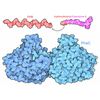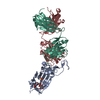+ Open data
Open data
- Basic information
Basic information
| Entry | Database: PDB / ID: 7zsk | ||||||
|---|---|---|---|---|---|---|---|
| Title | K3DAK4 bimodule core of BGC11 from Brevibacillus brevis. | ||||||
 Components Components | Putative polyketide synthase | ||||||
 Keywords Keywords |  BIOSYNTHETIC PROTEIN / BIOSYNTHETIC PROTEIN /  Ketosynthase / Ketosynthase /  polyketide synthase / thiolase fold / polyketide synthase / thiolase fold /  Claisen Condensation / Claisen Condensation /  dehydratase dehydratase | ||||||
| Function / homology |  Function and homology information Function and homology information phosphopantetheine binding / 3-oxoacyl-[acyl-carrier-protein] synthase activity / fatty acid biosynthetic process phosphopantetheine binding / 3-oxoacyl-[acyl-carrier-protein] synthase activity / fatty acid biosynthetic processSimilarity search - Function | ||||||
| Biological species |   Brevibacillus brevis NBRC 100599 (bacteria) Brevibacillus brevis NBRC 100599 (bacteria) | ||||||
| Method |  ELECTRON MICROSCOPY / ELECTRON MICROSCOPY /  single particle reconstruction / single particle reconstruction /  cryo EM / Resolution: 6.8 Å cryo EM / Resolution: 6.8 Å | ||||||
 Authors Authors | Tittes, Y.U. / Herbst, D.A. / Jakob, R.P. / Maier, T. | ||||||
| Funding support |  Switzerland, 1items Switzerland, 1items
| ||||||
 Citation Citation |  Journal: Sci Adv / Year: 2022 Journal: Sci Adv / Year: 2022Title: The structure of a polyketide synthase bimodule core. Authors: Yves U Tittes / Dominik A Herbst / Solène F X Martin / Hugo Munoz-Hernandez / Roman P Jakob / Timm Maier /  Abstract: Polyketide synthases (PKSs) are predominantly microbial biosynthetic enzymes. They assemble highly potent bioactive natural products from simple carboxylic acid precursors. The most versatile ...Polyketide synthases (PKSs) are predominantly microbial biosynthetic enzymes. They assemble highly potent bioactive natural products from simple carboxylic acid precursors. The most versatile families of PKSs are organized as assembly lines of functional modules. Each module performs one round of precursor extension and optional modification, followed by directed transfer of the intermediate to the next module. While enzymatic domains and even modules of PKSs are well understood, the higher-order modular architecture of PKS assembly lines remains elusive. Here, we visualize a PKS bimodule core using cryo-electron microscopy and resolve a two-dimensional meshwork of the bimodule core formed by homotypic interactions between modules. The sheet-like organization provides the framework for efficient substrate transfer and for sequestration of trans-acting enzymes required for polyketide production. | ||||||
| History |
|
- Structure visualization
Structure visualization
| Structure viewer | Molecule:  Molmil Molmil Jmol/JSmol Jmol/JSmol |
|---|
- Downloads & links
Downloads & links
- Download
Download
| PDBx/mmCIF format |  7zsk.cif.gz 7zsk.cif.gz | 2.1 MB | Display |  PDBx/mmCIF format PDBx/mmCIF format |
|---|---|---|---|---|
| PDB format |  pdb7zsk.ent.gz pdb7zsk.ent.gz | Display |  PDB format PDB format | |
| PDBx/mmJSON format |  7zsk.json.gz 7zsk.json.gz | Tree view |  PDBx/mmJSON format PDBx/mmJSON format | |
| Others |  Other downloads Other downloads |
-Validation report
| Arichive directory |  https://data.pdbj.org/pub/pdb/validation_reports/zs/7zsk https://data.pdbj.org/pub/pdb/validation_reports/zs/7zsk ftp://data.pdbj.org/pub/pdb/validation_reports/zs/7zsk ftp://data.pdbj.org/pub/pdb/validation_reports/zs/7zsk | HTTPS FTP |
|---|
-Related structure data
| Related structure data |  14945MC 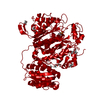 7zm9C 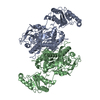 7zmaC  7zmcC 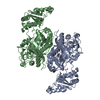 7zmdC  7zmfC M: map data used to model this data C: citing same article ( |
|---|---|
| Similar structure data | Similarity search - Function & homology  F&H Search F&H Search |
- Links
Links
- Assembly
Assembly
| Deposited unit | 
|
|---|---|
| 1 |
|
- Components
Components
| #1: Protein |  Mass: 187424.781 Da / Num. of mol.: 4 Source method: isolated from a genetically manipulated source Source: (gene. exp.)   Brevibacillus brevis NBRC 100599 (bacteria) Brevibacillus brevis NBRC 100599 (bacteria)Strain: 47 / JCM 6285 / NBRC 100599 / Gene: BBR47_39880 / Cell line (production host): Sf21 / Production host:   Spodoptera frugiperda (fall armyworm) / References: UniProt: C0ZGQ6 Spodoptera frugiperda (fall armyworm) / References: UniProt: C0ZGQ6 |
|---|
-Experimental details
-Experiment
| Experiment | Method:  ELECTRON MICROSCOPY ELECTRON MICROSCOPY |
|---|---|
| EM experiment | Aggregation state: PARTICLE / 3D reconstruction method:  single particle reconstruction single particle reconstruction |
- Sample preparation
Sample preparation
| Component | Name: Filamentous K3DAK4 bimodule core from Brevibacillus brevis BGC11 Type: COMPLEX / Entity ID: all / Source: RECOMBINANT |
|---|---|
| Molecular weight | Value: 0.187 MDa / Experimental value: NO |
| Source (natural) | Organism:   Brevibacillus brevis NBRC 100599 (bacteria) Brevibacillus brevis NBRC 100599 (bacteria) |
| Source (recombinant) | Organism:   Spodoptera frugiperda (fall armyworm) / Strain: SF21 Spodoptera frugiperda (fall armyworm) / Strain: SF21 |
| Buffer solution | pH: 7.5 |
| Specimen | Conc.: 0.075 mg/ml / Embedding applied: NO / Shadowing applied: NO / Staining applied : NO / Vitrification applied : NO / Vitrification applied : YES : YES |
| Specimen support | Grid material: COPPER / Grid mesh size: 300 divisions/in. / Grid type: EMS Lacey Carbon |
Vitrification | Instrument: LEICA PLUNGER / Cryogen name: ETHANE / Humidity: 95 % / Chamber temperature: 293 K |
- Electron microscopy imaging
Electron microscopy imaging
| Experimental equipment |  Model: Titan Krios / Image courtesy: FEI Company |
|---|---|
| Microscopy | Model: FEI TITAN KRIOS |
| Electron gun | Electron source : :  FIELD EMISSION GUN / Accelerating voltage: 300 kV / Illumination mode: FLOOD BEAM FIELD EMISSION GUN / Accelerating voltage: 300 kV / Illumination mode: FLOOD BEAM |
| Electron lens | Mode: BRIGHT FIELD Bright-field microscopy / Nominal defocus max: 1800 nm / Nominal defocus min: 800 nm / Cs Bright-field microscopy / Nominal defocus max: 1800 nm / Nominal defocus min: 800 nm / Cs : 2.7 mm / Alignment procedure: COMA FREE : 2.7 mm / Alignment procedure: COMA FREE |
| Specimen holder | Cryogen: NITROGEN / Specimen holder model: FEI TITAN KRIOS AUTOGRID HOLDER |
| Image recording | Electron dose: 67 e/Å2 / Detector mode: SUPER-RESOLUTION / Film or detector model: GATAN K2 SUMMIT (4k x 4k) |
- Processing
Processing
| Software | Name: PHENIX / Version: 1.20rc4_4425: / Classification: refinement | ||||||||||||||||||||
|---|---|---|---|---|---|---|---|---|---|---|---|---|---|---|---|---|---|---|---|---|---|
| EM software |
| ||||||||||||||||||||
CTF correction | Type: PHASE FLIPPING AND AMPLITUDE CORRECTION | ||||||||||||||||||||
| Particle selection | Num. of particles selected: 1288160 | ||||||||||||||||||||
| Symmetry | Point symmetry : C1 (asymmetric) : C1 (asymmetric) | ||||||||||||||||||||
3D reconstruction | Resolution: 6.8 Å / Resolution method: FSC 0.143 CUT-OFF / Num. of particles: 293391 / Num. of class averages: 1 / Symmetry type: POINT | ||||||||||||||||||||
| Atomic model building | B value: 693.88 / Protocol: AB INITIO MODEL / Space: REAL Details: Rigid body fits of the individual dimer models only. | ||||||||||||||||||||
| Atomic model building |
| ||||||||||||||||||||
| Refinement | Cross valid method: NONE |
 Movie
Movie Controller
Controller





 PDBj
PDBj
